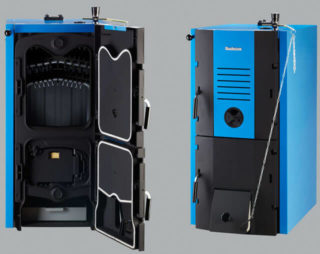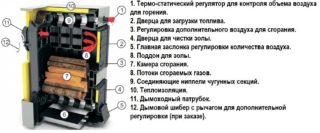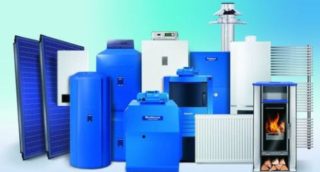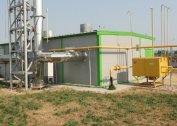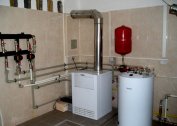Solid fuel boilers are diverse in design. The more complex they are, the more expensive the device, as well as its installation and maintenance. Simpler models are not always convenient, but understandable and easy to operate. This type of equipment includes a classic cast-iron boiler. Not all parts of such an assembly are made of cast iron, some of the elements of the device are made of ordinary steel with increased heat resistance.
Features of devices
The main feature of the device in question is its heat exchanger. It has a characteristic sectional structure assembled on special shafts (nipples) without the use of a weld. The capacity of the boiler depends on the number of such heating units - the more there are, the stronger its heat transfer. Building on separate elements makes it easier to solve problems with breakdowns and replacing with new failed parts.
Most often, due to the impressive weight, the solid fuel cast-iron boiler is made in the floor version. A solid concrete base is required for this design.
Positive and negative sides
If we take the cast iron and steel unit for comparison, we can note the following:
- Cast iron is more durable and can function properly for a quarter of a century, while steel structures rarely care for more than 12 years.
- The material is resistant to electrochemical and chemical corrosion.
- The heat exchanger does not require such frequent cleaning as steel, because virtually no rust is formed inside.
- Prefabricated sections can be easily untwisted and replaced by a new one, or simply reduce the size of the radiator.
The negative side of cast iron and all products made of this material is the danger of thermal shock. If cold water gets inside the hot metal, it is more likely to burst, which is never the case with ordinary steel. Also, during transportation, it is necessary to protect the product from mechanical stress. As a result of falling, a part may break off from the heat exchanger.
If you strictly adhere to the operating conditions, a cast-iron or steel boiler in most cases nurses its term.
Varieties of furnaces
There are various modifications of heat generators. By the type of solid fuel used are:
- Units for burning coal. They are characterized by increased strength of the walls of the combustion chamber.
- Pellet solid fuel heat generators. They work on wood and agropellets.
- Devices of long burning. They can be designed only for wood material or universal for any solid fuel.
- Pyrolysis heat generators with a cast-iron heat exchanger.
In addition to the type of fuel, boiler equipment may differ in power and performance of the furnace.
You should not experiment and use fuel that is not provided for by the passport data on the device, such actions obviously lead to disruption of the functioning of the hardware or the entire system as a whole.
Classical devices
Devices of this design are non-volatile and require electricity. The first view in shape is a vertically standing rectangle of metal with two doors on the facade. There is a classic firebox and an ash collection unit with a blower.Such a solid fuel boiler with a cast-iron heat exchanger is atmospheric without forced blowing.
Volatile models are no different in design from the above, but they have a lower door adapted for the installation of a pellet burner with automatic equipment. The burner itself is equipped with a fan, electric ignition, cleaning and control system.
Pyrolysis devices
Pyrolysis units with a sectional heat exchanger are intended only for the use of firewood and wood waste. Here, the afterburning method is used, in which the amount of harmful emissions into the atmosphere is reduced. The number of thermal sections in such systems determines the power of the boiler installation.
Most often, modern pyrolyzers are designed to work in a closed coolant circulation system. Therefore, a protective group must be present in the circuit that protects against overheating.
Design Features
The simplest solid-fuel sectional apparatus for the device is assembled from the following nodes:
- Metal case. This is the outer skin of the product, which simultaneously performs a supporting function - various components of the unit are attached to it inside and out.
- Heat exchanger. It is placed inside the furnace and is a set of sections made of cast iron, interconnected by threaded hardware with hermetic refractory gaskets and equipped with leads to the water circuit.
- The combustion chamber. It is made of thick-walled steel sheet and has the shape of a vertical rectangle.
- Door for loading firewood or other fuel on a solid basis. Located on the front panel at the top. It has a double wall: the inner one is made of heat-resistant thick-walled steel for fitting to the combustion chamber and the outer one is made of thin metal. The door is also equipped with a locking handle.
- Window of the ash pan. Located under the loading chamber, it also has a double design, is equipped with a handle for closing and a shutter for oxygen supply from below.
- Smoke exhaust pipe. This element is usually welded to the back or top of the body. Inside there is a chimney flap with a control lever brought to the front panel.
The supporting part of the furnace is usually made of two channels welded parallel to each other in the same plane.
Before installing the unit in a permanent place, you need to organize a concrete platform under it or check the quality and strength of the existing screed.
How to choose a cast iron boiler
The selection algorithm for boiler equipment with a cast iron heat exchanger does not differ from the selection of any other boiler. The main criteria:
- Power installation. Traditionally, a kilowatt of thermal energy is enough to heat 10 squares of a room.
- The number of circuits.
- Type of the entire heating system. There is equipment that is designed only for open or closed circuit.
- Overall dimensions, if there are restrictions on the size of the furnace.
Often the consumer still focuses on the manufacturer. Therefore, it is better to study information about the most popular and practical units for which you can always find parts.
Correctly selected cast iron boiler equipment will correspond to the declared operating parameters if the layout of the heat circuit is properly organized.
Popular Model Manufacturers
The Czech manufacturer Protherm produces low-power and high-power solid fuel heat generators. A design feature is the implementation of a heat exchanger combined with a furnace. Devices can work with gravity flow and forced circulation.
The German company Buderus specializes in the production of universal models of boiler equipment for any type of solid fuel.The power regulator in such devices works on the thermal principle.
